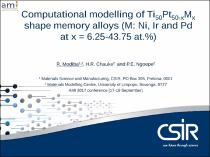 ResearchSpace
ResearchSpace
Computational modelling of Ti50Pt50-xMx shape memory alloys (M: Ni, Ir or Pd and x = 6.25-43.75 at.%)
JavaScript is disabled for your browser. Some features of this site may not work without it.
- ResearchSpace
- →
- Research Publications/Outputs
- →
- Conference Publications
- →
- View Item
| dc.contributor.author |
Modiba, Rosinah M

|
|
| dc.contributor.author |
Chauke, HR

|
|
| dc.contributor.author |
Ngoepe, PE

|
|
| dc.date.accessioned | 2017-11-30T06:52:48Z | |
| dc.date.available | 2017-11-30T06:52:48Z | |
| dc.date.issued | 2017-09 | |
| dc.identifier.citation | Modiba, R.M., Chauke, H.R. and Ngoepe, P.E. 2017. Computational modelling of Ti50Pt50-xMx shape memory alloys (M: Ni, Ir or Pd and x = 6.25-43.75 at.%). AMI Precious Metals 2017, 17-19 September, Polokwane, South Africa | en_US |
| dc.identifier.uri | http://www.saimm.co.za//media/com_eventbooking/AMI%20programme%2018092017.pdf | |
| dc.identifier.uri | https://twitter.com/SAIMM1/status/923078576550875136 | |
| dc.identifier.uri | http://hdl.handle.net/10204/9833 | |
| dc.description | Presentation delivered at AMI Precious Metals 2017, 17-19 September, Polokwane, South Africa | en_US |
| dc.description.abstract | The ab initio density functional theory approach was employed to study the effect of Ni, Ir or Pd addition to the TiPt shape memory alloy. The supercell approach in VASP was used to substitute Pt with 6.25, 18.75, 25.00, 31.25 and 43.75 at.% Ni, Ir or Pd in the B2 TiPt structure. The mechanical stability from elastic properties and phonon dispersion calculations of these alloys were then evaluated. Results suggest that Ni addition reduced the transformation temperatures of the TiPt alloy as indicated by an increase in shear modulus C'. Ir addition increased the martensitic transformation temperature of TiPt, since it gave the lowest shear modulus values at both 18.75 and 25 at.% Ir. However, a high addition of Pd (x = 25) decreased the transformation temperature of the B2 to B19 TiPt. | en_US |
| dc.language.iso | en | en_US |
| dc.relation.ispartofseries | Worklist;19856 | |
| dc.subject | Shape memory alloys | en_US |
| dc.subject | SMAs | en_US |
| dc.title | Computational modelling of Ti50Pt50-xMx shape memory alloys (M: Ni, Ir or Pd and x = 6.25-43.75 at.%) | en_US |
| dc.type | Conference Presentation | en_US |
| dc.identifier.apacitation | Modiba, R. M., Chauke, H., & Ngoepe, P. (2017). Computational modelling of Ti50Pt50-xMx shape memory alloys (M: Ni, Ir or Pd and x = 6.25-43.75 at.%). http://hdl.handle.net/10204/9833 | en_ZA |
| dc.identifier.chicagocitation | Modiba, Rosinah M, HR Chauke, and PE Ngoepe. "Computational modelling of Ti50Pt50-xMx shape memory alloys (M: Ni, Ir or Pd and x = 6.25-43.75 at.%)." (2017): http://hdl.handle.net/10204/9833 | en_ZA |
| dc.identifier.vancouvercitation | Modiba RM, Chauke H, Ngoepe P, Computational modelling of Ti50Pt50-xMx shape memory alloys (M: Ni, Ir or Pd and x = 6.25-43.75 at.%); 2017. http://hdl.handle.net/10204/9833 . | en_ZA |
| dc.identifier.ris | TY - Conference Presentation AU - Modiba, Rosinah M AU - Chauke, HR AU - Ngoepe, PE AB - The ab initio density functional theory approach was employed to study the effect of Ni, Ir or Pd addition to the TiPt shape memory alloy. The supercell approach in VASP was used to substitute Pt with 6.25, 18.75, 25.00, 31.25 and 43.75 at.% Ni, Ir or Pd in the B2 TiPt structure. The mechanical stability from elastic properties and phonon dispersion calculations of these alloys were then evaluated. Results suggest that Ni addition reduced the transformation temperatures of the TiPt alloy as indicated by an increase in shear modulus C'. Ir addition increased the martensitic transformation temperature of TiPt, since it gave the lowest shear modulus values at both 18.75 and 25 at.% Ir. However, a high addition of Pd (x = 25) decreased the transformation temperature of the B2 to B19 TiPt. DA - 2017-09 DB - ResearchSpace DP - CSIR KW - Shape memory alloys KW - SMAs LK - https://researchspace.csir.co.za PY - 2017 T1 - Computational modelling of Ti50Pt50-xMx shape memory alloys (M: Ni, Ir or Pd and x = 6.25-43.75 at.%) TI - Computational modelling of Ti50Pt50-xMx shape memory alloys (M: Ni, Ir or Pd and x = 6.25-43.75 at.%) UR - http://hdl.handle.net/10204/9833 ER - | en_ZA |





